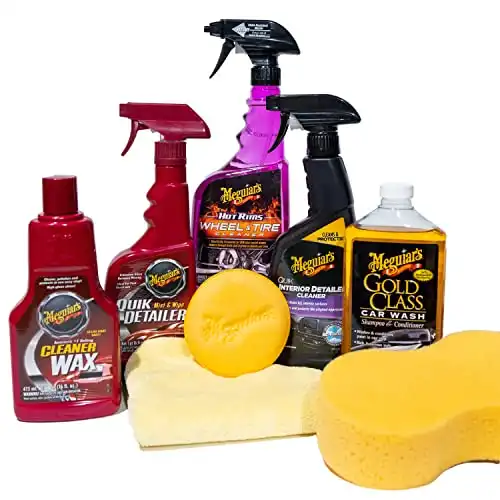I’ll bet your idea of how to clean garage doors is hosing it off once a year if it looks dirty.
There’s a bit more to it than that, especially if you’ve got a chalky garage door like the one below.
One of the craziest parts about becoming a homeowner was the regular maintenance that I wasn’t aware of.
I’ve written a quick guide on lubricating your garage door, which helps keep the door in tip-top working shape.
Cleaning garage doors is a simple process that can be just as quick and easy.
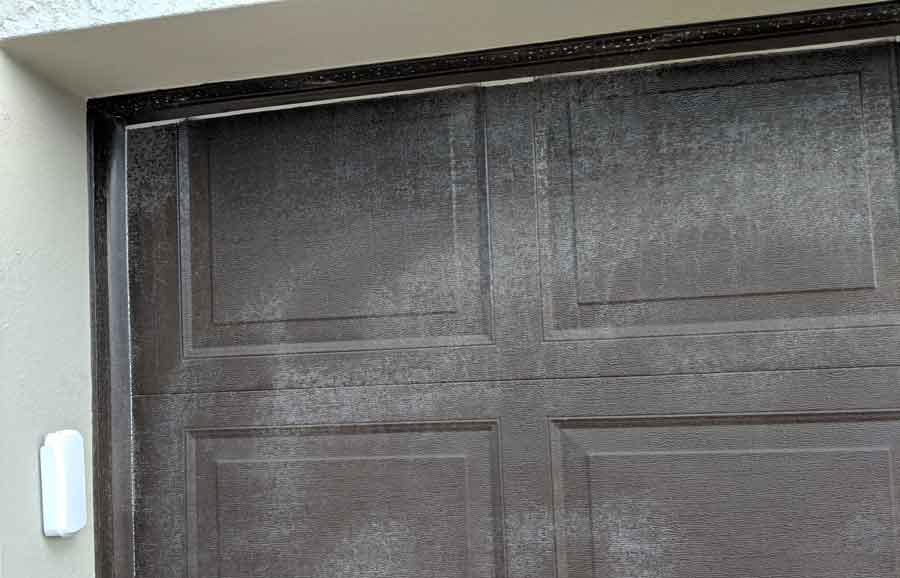
How Often Should You Clean Your Garage Door?
Your garage door is often the first impression people get of your home. Keeping it clean isn’t only about looking sharp. But it keeps it running smoothly for years to come.
Let’s break it down.
Dirt and grime are more than just an eyesore. They can gum up the works, leading to problems over time. Cleaning garage doors can save you a future headache (and a repair bill).
So, how often should you clean your garage door?
It depends on factors like your door’s construction, local weather, and the exposure to pollution from busy streets.
You should clean your garage door at least once each year.
Ideally, steel or fiberglass garage doors should be cleaned every two to three months. Vinyl doors require less maintenance and only require cleaning every six months.
Wood doors are more finicky. Constant exposure to the elements can damage the paint or stain. You’ll want to periodically examine your wood garage door for signs of wear. If you find any, address them quickly.
Dark colors like black, will show dirt and dust more easily. These garage doors will require more frequent cleaning.
While you’re in cleaning mode, it’s the perfect time for a mini-inspection. Look for any loose bolts, worn-out rollers, or cables.
Better safe than sorry, right?
Special Instructions for Certain Garage Door Materials
Your garage door’s material determines how you should care for it. Each material has its quirks, strengths, and vulnerabilities.
Let’s jump right into the specifics.
Aluminum: Aluminum garage doors are durable and rust-resistant but can show dents and scratches easily. To clean an aluminum garage door, use a mild detergent or car wash soap and a soft sponge or cloth. Rinse well with water and dry with a towel or a squeegee.
You can also apply a coat of wax to protect the finish and prevent oxidation.
Do not use abrasive or highly alkaline cleaners, such as ammonia, or scrape or scrub the door with sharp instruments, such as razors or brushes.
Fiberglass: Fiberglass garage doors can fade or crack over time. Use a mild detergent or car wash soap and a soft sponge or cloth to clean a fiberglass garage door. Rinse thoroughly with water and dry with a chamois or a soft sponge.
You can apply a liquid wax to your fiberglass door immediately after cleaning to restore the shine and protect the surface.
Do not use abrasive or highly alkaline cleaners, such as ammonia, or scrape or scrub the door with sharp instruments, such as razors or brushes.
Vinyl: Vinyl garage doors can stain or warp in extreme temperatures. Use a mild dish or car wash soap and a soft sponge or cloth to clean a vinyl garage door. Rinse off with water and dry with a towel.
You can use a general-purpose cleaner to remove any stubborn dirt or stains. Do not use abrasive cleaners, such as muriatic acid, or paste wax on the door.
Wood: Wood garage doors require more care and maintenance than other materials. They can rot, warp, crack, or fade if not properly cleaned and sealed. To clean a wooden garage door, use a mild household detergent mixed with warm water and a soft cloth or sponge. Remove any dirt, mildew, chalk, or contamination on the surface using a circular motion. Rinse the door with clean water and allow it to dry.
While cleaning, inspect the door for any signs of chipped paint or dulling finish on stained wood doors. You should sand down, repaint, re-stain, and properly seal the door if needed.
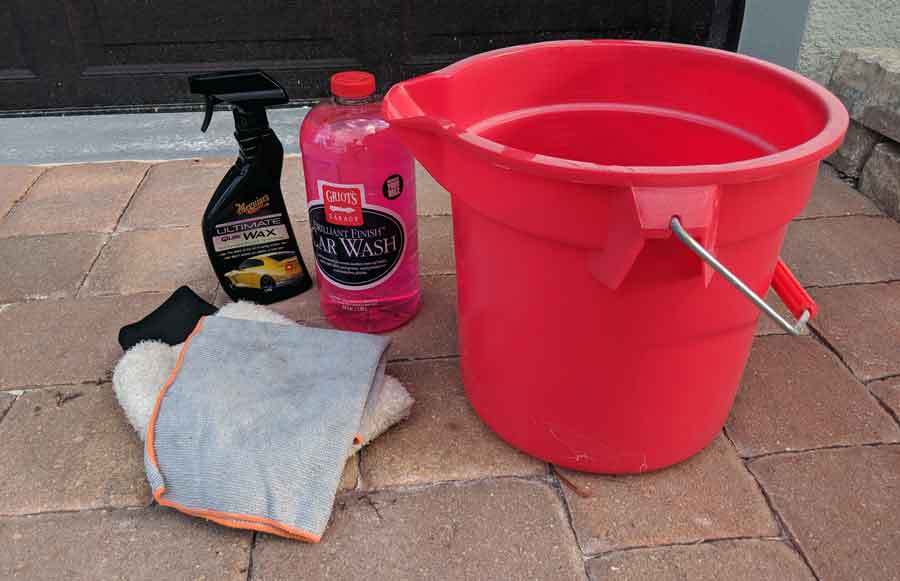
What Cleaning Supplies You’ll Need
Cleaning your garage door is very similar to cleaning your car. You’ll need some basic supplies you probably already have in your garage.
- Clean 3-5 gallon bucket: It’s good to have a specific bucket for washing your car and garage door. You don’t want to mix any other chemicals with your soapy water. It defeats the purpose of cleaning the door.
- Sponge, mitt, or wet cloth: Although you can use a large sponge to apply the soap to the door, I prefer a washing mitt. You can pick up a microfiber, wool, or sheepskin wash mitt for between $5-$10, which will last for years.
- Several clean, dry towels
- Step ladder (optional)
- Car wash soap or dish soap: Personally, I like car wash soap. Dish soap is designed to take “grease out of your way,” which isn’t necessary here. Spot-clean greasy areas (oil, WD-40, etc.) with mild detergent soap like Dawn.
- Meguiar’s Deep Crystal Car Wash
- Griot’s Garage Brilliant Finish Car Wash
- Spray or liquid wax: Never use paste wax. My wife tried to use paste wax on our garage door, and the wax was drying and caking on before she could wipe it off. Most garage doors are textured, so spray wax will help get into the nooks and crannies of your door’s surface.
- Meguiar’s Ultimate Quik Wax
- Mothers California Gold Spray Wax
- Griot’s Garage Spray-On Wax
How to Clean Garage Doors (Step-by-Step)
It shouldn’t take more than fifteen minutes to clean your garage door from start to finish.
It’s a simple cleaning process that helps enhance your home’s exterior and give you more curb appeal in your neighborhood!
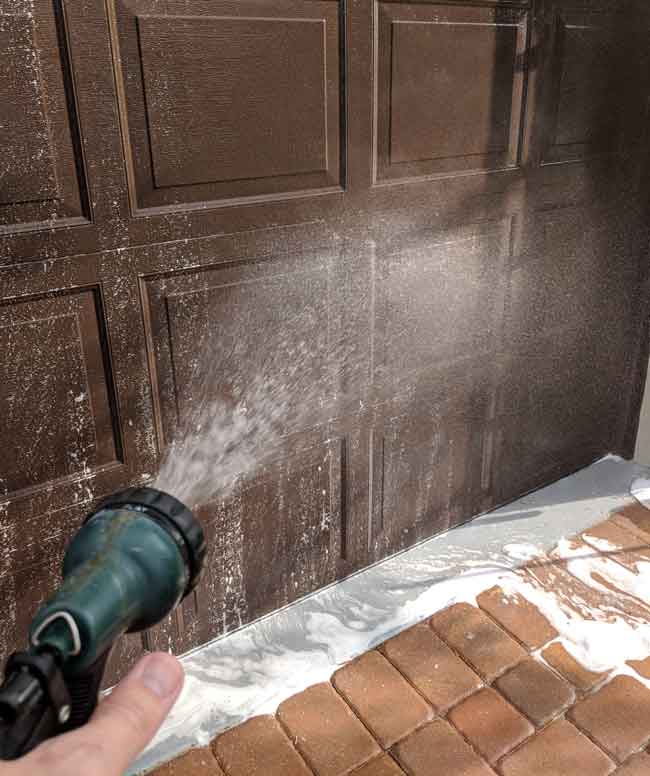
Step 1: Pre-Rinse
Even though you’re not going to use a pressure washer, you still want to get all of the loose dust and dirt off the door before you soap it down. Most automotive soaps work best when applied to a wet surface.
If you skip this step and go straight to applying soap with a sponge or mitt, you may just push the dirt around the door and damage its finish.
Rinse off the door and the surrounding weather stripping and door trim with a medium-strength spray.
Use a gentle setting on your hose nozzle. The object here is to remove dirt and grime off your door’s surface and let the soap do its job.
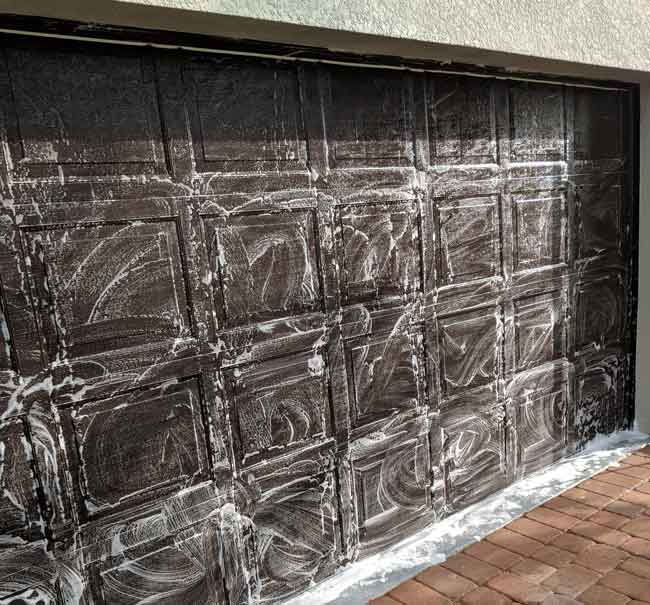
Step 2: Apply car-wash soap using a sponge or mitt
Apply the car wash soap with your sponge or washing mitt. Starting at one of the top corners, work your way across and down the door.
This is easy if your door is blocked into rows of squares like mine.
I started on the top left corner, working my way across that row before moving down and back across the next row.
Remember your Karate Kid training here. Circular motions (wax-on\wax-off) will be the most effective.
Step 3: Rinse off with your garden hose
Use the same nozzle setting you used previously.
You don’t need a powerful spray here. You’re just trying to get the soap off the door.
Now’s a good time to see if you missed any spots or if you’ve got any stubborn dirt or stains that need some extra attention.
Step 4: Wax and Dry
Depending on what spray wax you use, you may need to dry your garage door before you wax it. Some spray waxes can be applied when still wet, so check the instructions to be sure.
Grab a clean, dry cloth and your bottle of spray wax.
Use the same process as you did for applying soap. Start at one of the top corners and work your way across the door, before moving down a row and starting back the way you came.
Use circular motions with your cloth. This removes any excess wax and will help polish your garage door’s finish as well.
Step 5: Clean your weather stripping
This is the step that almost everybody ignores…but not you, right?
The weatherstripping around your garage door provides a seal to keep out extreme weather and common garage bugs.
Use a general purpose cleaner and go over the weather stripping around the garage door’s edges, and the rubber seal on the bottom of the door.
While you’re cleaning garage doors, inspect for any cracks or tears.
If you find them, take care of them. Once the weather stripping is cracked, it needs to be fixed or replaced as soon as possible.

How to Clean Garage Door Windows
Garage door windows can add a touch of elegance and allow natural light to flood in. But like any good feature in a home, they need some love to keep shining.
Each has a cleaning playbook, from the classy glass windows to the sturdy acrylic and polycarbonate.
Glass Windows: Clean glass windows using mild dishwashing soap paired with a soft cloth or sponge. After washing, rinse them off and towel dry or squeegee them for that streak-free shine.
Acrylic Windows: More durable than glass, acrylic windows come with their cleaning nuances. Reach out for a mild detergent or car wash soap with a gentle sponge or cloth. Rinse well, then gently pat dry with a chamois or a moist cellulose sponge. Never use ammonia-based cleaners on acrylic windows.
Polycarbonate Windows: These windows are super tough and can handle a lot. Use mild soap or detergent mixed with lukewarm water. After washing, rinse them thoroughly and dab dry with a chamois or a moist cellulose sponge.
Garage door windows aren’t the same as other windows in your home.
They need special care because they’re exposed to the elements, the occasional rogue basketball, and the curious hands of kids.
- Avoid abrasive cleaners or those high-on-alkaline baddies like ammonia. They’re just not window-friendly.
- Scrubbing with sharp instruments? Big no-no. Tools like razors or brushes could leave scars on your precious windows.
- That perfect sunny day might seem tempting, but cleaning garage door windows in direct sunlight or extreme temperatures can lead to streaks. You want clear views, not cloudy ones.
- While paste wax is a charm on some surfaces, it’s not your window’s best friend. Steer clear.
While you’re making those windows sparkle, take a moment to check the frames and seals.
Look for any signs of wear, like cracks, gaps, or even corrosion. This can give you a heads-up on any maintenance work coming your way.
Waxing Your Garage Door
Waxing isn’t just about aesthetics; it’s a critical measure for the longevity and protection of your garage door. Here’s why:
Preservation: Wax is a protective barrier for the door’s finish, reducing the risk of rust and oxidation. This is especially beneficial in areas where rain is frequent.
Protection: Waxing protects against common environmental adversaries like dirt, dust, moisture, and UV rays. As a result, it aids in keeping the door’s appearance intact, even under challenging conditions.
Enhanced Appearance: A well-waxed garage door not only reflects sunlight beautifully but also enriches its color, boosting the overall curb appeal of your property.
Improved Performance: Wax reduces friction between moving parts, ensuring the door operates smoothly and efficiently.
Homeowners with steel, fiberglass, and custom-painted doors should periodically wax their garage doors. Do it at least twice yearly, typically in the spring and late fall.
However, if you live in coastal regions or where road salt is used, consider waxing more often to help protect your garage door’s finish.
Cleaning Garage Doors: What Not To Do
Cleaning garage doors seems easy. Although there are some shortcuts that you can take, some may cause more trouble than they’re worth.
Here’s what you need to steer clear of:
1. Avoid Using Pressure Washers
While pressure washers can be a lifesaver on your driveway, they’re a no-go for your garage door. Using them incorrectly can risk harming the door’s finish, mess up the weather stripping, and potentially void any warranties you have on your garage door.

2. Do Not Wash Your Garage Door in Direct Sunlight
Avoid washing your garage door in direct sunlight. The heat can dry the cleaning agents too quickly, leading to streaks. The result is a not-so-clean finish and a lot more effort on your part. Early mornings or late afternoons are the best times for this task.
3. Never Use Bleach
My mother is the type of person to use pure bleach on everything because there’s nothing like the raw cleaning power of undiluted bleach. That makes it her go-to cleaning product. There’s only one problem: it’s incredibly harsh. My mom has bleached things so often that she’s literally burned off her fingerprints.
Imagine what that could do to your garage door’s protective finish or paint.
Wrapping It Up
Cleaning garage doors does more than boost your home’s curb appeal. It helps ensure the door’s longevity, performance, and fewer headaches down the line.
Whether you’re waxing, washing, or just checking for wear and tear, armed with this knowledge, your garage door will thank you. And when your neighbor leans over the fence, green with envy at your pristine garage door, just give a knowing smile and maybe share a tip or two if you’re feeling generous.
If cleaning it doesn’t have the impact you wanted, it may be time to give your garage door a fresh coat of paint.

